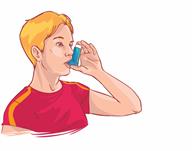Asthma Attack Prevention, Adult
Although you may not be able to change the fact that you have asthma, you can take actions to prevent episodes of asthma (asthma attacks).
How can this condition affect me?
Asthma attacks (flare ups) can cause trouble breathing, high-pitched whistling sounds when you breathe, most often when you breathe out (wheeze), and coughing. They may keep you from doing activities you like to do.
What can increase my risk?
Coming into contact with things that cause asthma symptoms (
asthma triggers) can put you at risk for an asthma attack. Common asthma triggers include:
- Things you are allergic to (allergens), such as:
Dust mite and cockroach droppings.
Pet dander.
Mold.
Pollen from trees and grasses.
Food allergies. This might be a specific food or added chemicals called sulfites.
- Irritants, such as:
Weather changes including very cold, dry, or humid air.
Smoke. This includes campfire smoke, air pollution, and tobacco smoke.
Strong odors from aerosol sprays and fumes from perfume, candles, and household cleaners.
- Other triggers, such as:
Certain medicines. This includes NSAIDs, such as ibuprofen and aspirin.
Viral respiratory infections (colds), including runny nose (rhinitis) or infection in the sinuses (sinusitis).
Activity, including exercise, laughing, or crying.
Not using inhaled medicines (corticosteroids) as told.
What actions can I take to prevent an asthma attack?
-
Stay healthy. Stay up to date on all immunizations as told by your health care provider, including the yearly flu (influenza) vaccine and pneumonia vaccine.
-
Many asthma attacks can be prevented by carefully following your written asthma action plan.
Follow your asthma action plan

Work with your health care provider to create a written asthma action plan. This plan should include:
A list of your asthma triggers and how to avoid or reduce them.
A list of symptoms that you may have during an asthma attack.
Information about which medicine to take, when to take the medicine, and how much of the medicine to take.
Information to help you understand your peak flow measurements.
Daily actions that you can take to prevent (control) your asthma symptoms.
Contact information for your health care providers.
If you have an asthma attack, act quickly. Follow the emergency steps on your written asthma action plan. This may prevent you from needing to go to the hospital.
Monitor your asthma. To do this:
- Use your peak flow meter every morning and every evening for 2–3 weeks or as told by your health care provider.
Record the results in a journal.
A drop in your peak flow numbers on one or more days may mean that you are starting to have an asthma attack, even if you are not having symptoms.
When you have asthma symptoms, write them down in a journal.
Write down in your journal how often you need to use your fast-acting rescue inhaler. If you are using your rescue inhaler more often, it may mean that your asthma is not under control. Talk with your health care provider about adjusting your asthma treatment plan to help you prevent future asthma attacks and gain better control of your condition.
Lifestyle
-
Avoid or reduce contact with known outdoor allergens by staying indoors, keeping windows closed, and using air conditioning when pollen and mold counts are high.
-
Do not use any products that contain nicotine or tobacco. These products include cigarettes, chewing tobacco, and vaping devices, such as e-cigarettes. If you need help quitting, ask your health care provider.
-
If you are overweight, consider a weight-loss plan.
-
Find ways to cope with stress and your feelings, such as mindfulness, relaxation, or breathing exercises.
-
Ask your health care provider if a breathing exercise program (pulmonary rehabilitation) may be helpful to control symptoms and improve your quality of life.
Medicines

Activity
-
-
Centers for Disease Control and Prevention:
www.cdc.gov
-
-
-
Summary
-
Asthma attacks (flare ups) can cause trouble breathing, high-pitched whistling sounds when you breathe, most often when you breathe out (wheeze), and coughing.
-
Work with your health care provider to create a written asthma action plan.
-
Do not stop taking your medicine and do not take less medicine even if you are feeling better.
-
Do not use any products that contain nicotine or tobacco. These products include cigarettes, chewing tobacco, and vaping devices, such as e-cigarettes. If you need help quitting, ask your health care provider.
This information is not intended to replace advice given to you by your health care provider. Make sure you discuss any questions you have with your health care provider.
 Work with your health care provider to create a written asthma action plan. This plan should include:
Work with your health care provider to create a written asthma action plan. This plan should include: